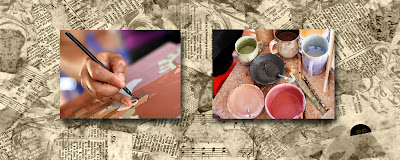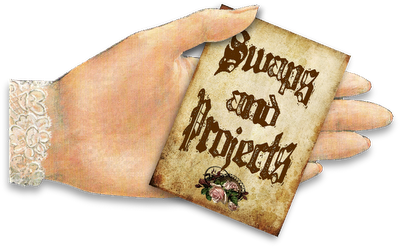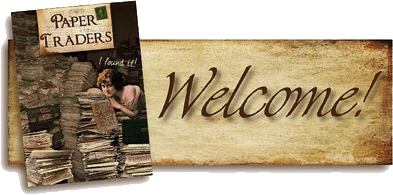The Paper Traders Art Group
Mods were discussing various ways to rust metal/tin to use in art projects and
we came across various tutorials in the blogosphere on how to do this, so we decided
to give several of them a try and share the results with you.
These tutorials came from the following:
Gather your materials:
various metal tins (I used an Altoid tin, a mint tin from Starbucks,
and a purchased tin from Michaels)
bleach
vinegar
hydrogen peroxide (HP)
sea salt or other non-iodized salt
newspapers or other protective cover for your table
glass or plastic bowls
plastic gloves
protective face mask for breathing
goggles
Roughly sand your tins with a very coarse sandpaper. I used a #50 grade. The more paint and sealant you remove, the better the results.
You can also remove paint with oven cleaner and by burning the tin.
Here are a couple of links with tips on this:
You must do this in a well-ventilated, preferably an outside location; and wear gloves, a mask, and goggles. Keep pets and children away. Please take every precaution.
Recipe 1: HP & Salt.
Fill a bowl with enough HP to cover the tin.
Dip tin in, pull out wet, and lay on newspaper.
Sprinkle with salt and let sit.
As you can see, the rust is starting to form around the salt rather quickly. However, after letting it sit for several minutes (5-7), when I wiped the salt off, the rust wiped off as well and there was no noticeable change on the tin. I repeated the steps several times and still no results. This may work over several hours but in the time I allotted (1 hour), I did not see any permanent changes.
I decided to research this a little more and came across a
Metal Artists site that had a varied take on
this recipe and it produced much better results.
Basically, after sanding your tin, you need to
“pickle” your tin in vinegar for a few minutes.
The Vinegar will corrode the metal lightly and so will rust better.
I set my tins in the vinegar for approximately 3 mins. on each side.
I used a Sea Salt and HP solution of 2 oz. HP
with 1 tsp. of sea salt in a spray bottle.
Let the salt dissolve in the HP before spaying.
As you can see it started to bubble immediately. I sprayed
The tin about every 2- 3 mins, changing sides as I sprayed.
Another tin after about 20 mins:
I needed to run a few errands ( yes, life gets in the way of art)
and so decided I would just set the tins in the solution
on a glass plate. When I came home, 2 hours later,
I was very happy with the results.
Recipe 2: 2 parts Bleach & 1 part Vinegar
Reminder: You must do this in a well ventilated, preferably outside location and wear gloves and mask and goggles. Keep pets and children away. (I did this outside on my porch with a fan blowing and the fumes were still very bad for this particular recipe.)
Within 5-10 seconds rust was already forming:
This was after about 5 mins:
This was after about 10 mins:
This was after about 20 mins. I poured some of the mixture
into a shallow bowl and just let the bottom of the tin
soak in the mixture for about another 15 mins.
It rusted less because of the paint and
sealant remaining on the outside of the tin.
This is why you want to sand the tin well before you start.
As you can see you get a pretty deep rust rather quickly with this recipe.
I then added the round purchased tin from Michaels. I had to sand this quite a bit because of the sealant on it.
After 45 mins:
After it completely dried it looked much better:
Recipe 3: 1 cup HP, 1/8 cup of Vinegar, 1 Tbsp. Salt
This is the recipe I prefer as the fumes are much less noxious. It takes a good 45 mins to get results but I think it is the safer way to go.
It will start to bubble pretty quickly:
After 15 minutes, lots of bubbles:
Results after 45 mins, inside of the Starbucks mint tin – Nice rust, not as orange or as corroded looking as Recipe #1, but a good color:
Outside of tin.
An Altoid tin with the same recipe.
When you pull your tins out of the solutions, DO NOT dry them off. Let them air dry naturally or you will wipe off some of the rust. I set mine on paper towels and I got some pretty cool rusty towels that I am sure I can use later for collage. When completely dry, you can seal your tins with varnish, if you prefer.
We hope you enjoyed our
tutorial on rust. Please remember to be
safe if you try any of these methods.
And we invite you to share comments about your own experiences with
various rusting techniques. Have fun!
~Cathy Calamas






































